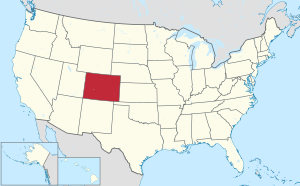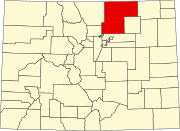Weld County, Colorado
Weld County | |
|---|---|
 Location within the U.S. state of Colorado | |
 Colorado's location within the U.S. | |
| Coordinates: 40°32′N 104°24′W / 40.54°N 104.4°W | |
| Country | |
| State | |
| Founded | November 1, 1861 |
| Seat | Greeley |
| Largest city | Greeley |
| Area | |
• Total | 4,022 sq mi (10,420 km2) |
| • Land | 3,992 sq mi (10,340 km2) |
| • Water | 29 sq mi (80 km2) 0.72% |
| Population (2000) | |
• Total | 180,936 |
| • Density | 50/sq mi (18/km2) |
| Website | www |
Weld County is the third most extensive and the ninth most populous of the 64 counties of the State of Colorado of the United States. The United States Census Bureau estimates that the county population was 236,857 in 2006, a 30.91% increase since U.S. Census 2000.[1] The county seat is Greeley. The Greeley Metropolitan Statistical Area comprises Weld County.
History
On May 30, 1854, the Kansas-Nebraska Act created the Nebraska Territory and the Kansas Territory, divided by the Parallel 40° North (Baseline Road or County Line Road or Weld County Road 2 in the future Weld County). Present-day Weld County, Colorado, lay in the southwestern portion of the Nebraska Territory, bordering the Kansas Territory.

In July 1858, gold was discovered along the South Platte River in Arapahoe County, Kansas Territory. This discovery precipitated the Pike's Peak Gold Rush. Many residents of the mining region felt disconnected from the remote territorial governments of Kansas and Nebraska, so they voted to form their own Territory of Jefferson on October 24, 1859. The following month, the Jefferson Territorial Legislature organized 12 counties for the new territory, including St. Vrains County. St. Vrains County was named in honor of Ceran de Hault de Lassus de St. Vrain, the French trader who established the first trading post on the upper South Platte River. St. Vrains County encompassed much of what is today Weld County.
The Jefferson Territory never received federal sanction, but on February 28, 1861, U.S. President James Buchanan signed an act organizing the Territory of Colorado.[2] On November 1, 1861, the Colorado General Assembly organized 17 counties, including Weld County, for the new Colorado Territory. Weld County was named for Lewis Ledyard Weld, a lawyer and territorial secretary. He died while serving in the Union Army during the Civil War.[1] Until February 9, 1887, Weld County's boundaries included the area now comprising Weld County, Washington County, Logan County, Morgan County, Yuma County, Phillips County, and Sedgwick County.
Weld County was thrust into the media spotlight on the evening of November 1, 1955, when United Airlines Flight 629, a Douglas DC-6B airliner flying from Denver to Portland, Oregon, exploded in midair and crashed, killing all 44 persons on board the plane and scattering bodies, wreckage and debris over a six-square-mile area of the county. The subsequent investigation of the accident revealed that Denver resident John Gilbert Graham had secretly placed a time bomb composed of 25 sticks of dynamite in a suitcase belonging to his mother, who was a passenger on the airplane. Graham was tried and convicted of the crime, and executed in 1957.
In northeastern Weld County, Minuteman III missile silo "N-8"[2], one of the many unmanned silos there, was the target of symbolic vandalism by Catholic peace activists in 2002.[3][4]
Geography
Weld County lies within the relatively flat eastern half of Colorado; the northeastern portions of the county contain the extensive Pawnee National Grassland and the Pawnee Buttes, which jut 250 feet above the surrounding terrain. Along the western border some low hills betray the presence of the foothills of the Rocky Mountains further west.
The county is served by two interstate highways: I-25 (US 87) runs through the southwestern corner and I-76 from the south central edge northeastward to the Morgan county border. Other major roads include US 85 and US 34, which intersect near Greeley, and State Highway 14, which runs through Ault.
According to the U.S. Census Bureau, the county has a total area of 4,022 square miles (10,416 km²), of which, 3,992 square miles (10,340 km²) of it is land and 29 square miles (75 km²) of it (0.72%) is water.
Note: All figures for area and population given above were as of the 2000 census. The area has been reduced since November 15, 2001 with the creation of the new Broomfield County from part of Weld County and parts of Adams, Boulder, and Jefferson counties.
Adjacent counties
- Kimball County, Nebraska - northeast
- Logan County, Colorado - east
- Morgan County, Colorado - east
- Adams County, Colorado - south
- City and County of Broomfield, Colorado - southwest
- Boulder County, Colorado - west
- Larimer County, Colorado - west
- Laramie County, Wyoming - northwest
Demographics
| Census | Pop. | Note | %± |
|---|---|---|---|
| 1900 | 16,808 | — | |
| 1910 | 39,177 | 133.1% | |
| 1920 | 54,059 | 38.0% | |
| 1930 | 65,097 | 20.4% | |
| 1940 | 63,747 | −2.1% | |
| 1950 | 67,504 | 5.9% | |
| 1960 | 72,344 | 7.2% | |
| 1970 | 89,297 | 23.4% | |
| 1980 | 123,438 | 38.2% | |
| 1990 | 131,821 | 6.8% | |
| 2000 | 180,936 | 37.3% |
As of the censusTemplate:GR of 2000, there were 180,936 people, 63,247 households, and 45,221 families residing in the county. The population density was 45 people per square mile (18/km²). There were 66,194 housing units at an average density of 17 per square mile (6/km²). The racial makeup of the county was 81.71% White, 0.56% Black or African American, 0.87% Native American, 0.83% Asian, 0.08% Pacific Islander, 13.29% from other races, and 2.65% from two or more races. 27.05% of the population were Hispanic or Latino of any race.
There were 63,247 households out of which 37.20% had children under the age of 18 living with them, 57.60% were married couples living together, 9.40% had a female householder with no husband present, and 28.50% were non-families. 21.00% of all households were made up of individuals and 6.90% had someone living alone who was 65 years of age or older. The average household size was 2.78 and the average family size was 3.25.
In the county the population was spread out with 28.20% under the age of 18, 13.20% from 18 to 24, 29.70% from 25 to 44, 20.00% from 45 to 64, and 9.00% who were 65 years of age or older. The median age was 31 years. For every 100 females there were 100.60 males. For every 100 females age 18 and over, there were 98.00 males.
The median income for a household in the county was $42,321, and the median income for a family was $49,569. Males had a median income of $35,037 versus $25,757 for females. The per capita income for the county was $18,957. About 8.00% of families and 12.50% of the population were below the poverty line, including 14.60% of those under age 18 and 8.50% of those age 65 or over.
Cities and Towns
Cities
Towns
- Ault
- Berthoud ‡
- Eaton
- Erie‡
- Firestone
- Frederick
- Garden City
- Gilcrest
- Grover
- Hudson
- Johnstown‡
- Keenesburg
- Kersey
- La Salle
- Lochbuie‡
- Lucerne
- Mead
- Milliken
- Nunn
- Pierce
- Platteville
- Raymer
- Severance
- Windsor‡
CDP
Unincorporated communities
‡ means a populated place has portions in an adjacent county or counties
Economy
Weld County is Colorado's leading producer of cattle, grain and sugar beets, and is the richest agricultural county in the United States east of the Rocky Mountains, and the fourth richest overall nationally. It is also becoming more important as a milk producing county, with close to half of the state's cattle.[5][6]
Tornadoes
Surprisingly since 1950, Weld County has been hit by the most tornadoes of any county in the United States. There were several tornado reports on May 22, 2008.
National grassland
State museum and park
Historic trail
Recreational trails
Scenic byway
See also
- St. Vrains County, Jefferson Territory
- Colorado census statistical areas
- Colorado counties
- Colorado metropolitan areas
- Colorado municipalities
- Denver-Aurora-Boulder Combined Statistical Area
- Front Range Urban Corridor
- Greeley Metropolitan Statistical Area
References
- ^ "Annual County Population Estimates and Estimated Components of Change: April 1, 2000 to July 1, 2006 (CO-EST2006-alldata)" (CSV). 2006 Population Estimates. United States Census Bureau, Population Division. 2007-03-22. Retrieved 2007-05-10.
- ^ "An Act to provide a temporary Government for the Territory of Colorado" (PDF). Thirty-sixth United States Congress. 1861-02-28. Retrieved 2007-11-26.


